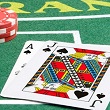
The American variants of blackjack are those that are played in the land casinos of Vegas Strip, Vegas Downtown and Atlantic City. Though there are minor differences in rules in these three blackjack variants, the treatment is identical as far as the initial dealing of the dealer’s cards is concerned. The first dealer card is dealt face up and the second dealer card is dealt face down. The face down card is also referred to as the hole card. In the European land casinos the initial dealing of the dealer’s cards is different. The first card is dealt face up but the second card is not dealt initially. Therefore the European version of blackjack is referred to as the “no hole” variant. Most online casinos today offer the American and European variants and hence it is important for players to understand the implications on the game play and strategy.
In American variants of blackjack if the dealer’s face up card is an ace the player has the option of placing the insurance bet before any other move is made. The insurance bet is half of the ante bet. The dealer then checks the hole card for blackjack, without exposing it to the player. If the dealer has a blackjack then the player loses his ante bet. But if he had placed the insurance bet then he receives a payout of 2 to 1 on that bet. If the dealer does not have a blackjack then the player loses the insurance bet and the game carries on in the normal manner. If the dealer’s face up card is a ten value card then the dealer checks his hole card for blackjack. There is no insurance bet option in this case. If the dealer has a blackjack the player loses his ante wager. If the dealer does not have a blackjack then the game carries on in the normal manner.
In European blackjack there is no hole card and therefore immediately checking for blackjack is not possible. The game play proceeds in the following manner. If the dealer’s face up card is an ace, the player can place the insurance bet as in the case of American blackjack variants. This bet is, however, settled later in the game. The player first completes his moves and either busts or stands on all his hands. The dealer then deals his second card face up. If the dealer then gets a blackjack, the insurance bet pays 2 to 1, otherwise the insurance bet loses. The dealer’s face up card being a ten value card has no special significance for the game play.
The American variants and European Blackjack call for a difference in strategy as well. In blackjack the player has the option of placing additional wagers while splitting or doubling hands. These increase his stake. In American blackjack variants the player has to make such decisions after the dealer checks for blackjack and does not have one. However in European Blackjack, the player will not know if the dealer has a blackjack until after he has taken the call on additional wagers for split and double moves. Therefore it is conceivable that he increases his stake and then loses to a blackjack. American blackjack variants therefore have marginally lower house edges and allow the player to be aggressive in split and double moves. In European blackjack the player has to be conservative in doubling and splitting once the dealer’s face up card is an ace or ten value card.





